The Last comforts of Namche Bazaar
As the sun once again shined through the cool window of my teahouse, I looked out over the tin roofs and the cascading buildings of Namche Bazaar, and smiled. The view was amazing to wake up to, and I actually remembered to keep my water bottle in my sleeping bag so it didn’t freeze in the night. There would be no time to relax this morning though.
It was day 3 of the Everest Base Camp Hike and I was planning to beat the crowds to Tengboche and ensure I had a comfortable place to sleep tonight. Once the groups arrive in a town it tends to be hard to find a good teahouse. After settling in I would visit the legendary Tengboche Monastery that I had been hearing so much about.
The Tengboche monastery had suffered during the last notable earthquake to hit this region but had since been rebuilt. The monastery allows visitors to walk through the monastery and observe the monks performing their morning and evening chants. So, with a full day of walking ahead, and Buddhist cultural experience to top it off, I quickly hopped up, rolled up my sleeping bag, and packed my odds and ends before heading downstairs to the quaint dining room of my teahouse.
While the hostess was prepping the cushy French toast breakfast I was treating myself to, I sent the last of the emails to family and friends to let them know everything was fine. I filled my water bottles and added the purification tablets while double checking the distances on my map for the day’s hike. Namche Bazaar to Tengboche: 10 kilometers, 430 meters of elevation gain, and 5 to 6 hours on a slow day. Easy stuff.

The Everest Base Camp Trek trail leaving Namche Bazaar toward Tengboche
Off to Tengboche
The stone trail that crawled up the hill out of Namche Bazaar was packed with trekkers on the Everest Base Camp hike aiming to be the first out of town. Lucky for me, I had a secret weapon…Snickers bars, and I didn’t have to wait for people in my group stopping to pee, so, as the day went on I would steadily pass the groups, one by one, while they stopped for roadside lunches and snack breaks.
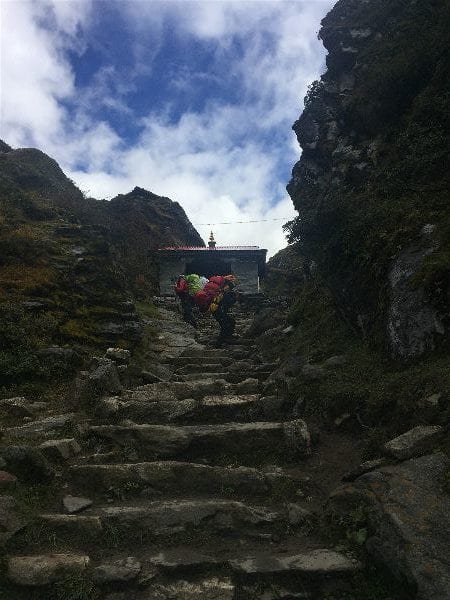
A stone set of stairs on the way from Namche Bazaar to Tengboche
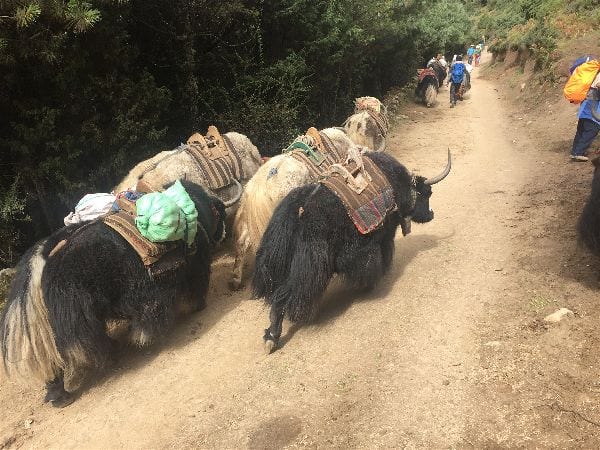
Herds of trekkers (literally) fill the path between Namche Bazaar and Tengboche
The road from Namche Bazaar to Tengboche was well trodden and actually under construction. Locals had taken it upon themselves to carve out a wider road laying large stones as the new foundation to hold the dirt in place. The result (I imagine) will be a hard-packed road nearly wide enough to drive a small car up. The project makes sense; it’s safer, allows more traffic, and makes the movement of the yaks (and porters) much easier. Signs were posted saying that this was a volunteer project so I gladly donated a few rupees. Amount: 100 Nepali Rupees. Donor: the Republic of California

Attempting to improve the face of America abroad I donated to the Everest Base Camp hike trail construction…in the name of the Republic of California…
Today’s trek felt great, almost empowering. I could breathe easier and my legs felt lighter than the day before. My body was absolutely more acclimatized than day 1, two days ago. This was also the first time I had used trekking poles before…and they were amazing! It makes so much sense. Four legs are much more efficient than two. But the “430 meters of elevation gain” on the map was quite deceptive.
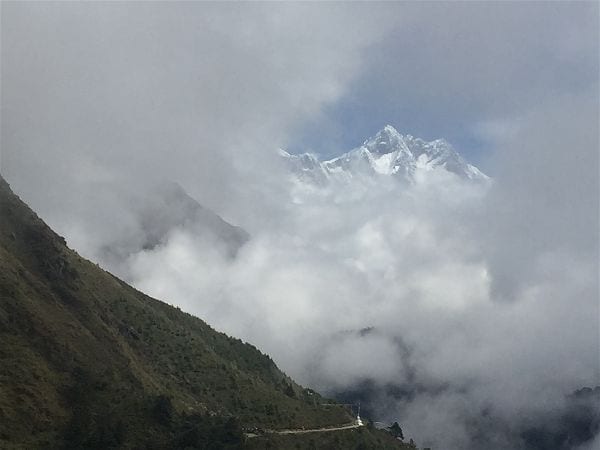
A view of Himalayan peaks cresting above the clouds on the road to Tengboche
The trail from Namche carves down to the valley floor before ascending high back onto the mountain, where Tingboche rests atop, so the elevation change felt more like 750 meters of climbing up. Following the “slow and steady mantra” and wishing not to repeat my turbo mistakes and altitude sickness gamble from Day 1, I took it slow only aiming to enjoy my hike up.
Arriving in Tengboche
As I arrived in the city of Tengboche I quickly noticed the stark contrast between Namche Bazaar and the cities at higher elevation. Namche was a bustling backpacker megacity by comparison, the bustling metropolis of the Everest Base Camp hike, equipped with the comforts of home and plenty of teahouses and hotels. On the other hand, in Tengboche and the cities on the way to Tengboche I could count the number of teahouses available on one hand.
I scurried to the first (and nicest) teahouse I saw, which was more like a hotel with a large heated dining room, bar, and even board games strewn about, but it was already fully booked. On walking out, I saw another herd of 10 trekkers walking into town about to play the same game I was playing – find the nicest place to sleep before all of the available beds run out – so I skipped my second choice and went right to my third, hoping something would still be available. It absolutely was, and I was lucky enough to share the tiny establishment with the group I will dub the “Chinese Delegation.”
The Chinese delegation was a group of 6 trekkers, clearly Chinese tourists, two of which were women. And the women were polar opposites. One woman appeared to be a mute. Ok, not really, but I only heard a couple of sounds come out of the quitter one and I’m not sure they were actually words. The other female Chinese traveler yelled. Constantly. I’m not sure what she was upset or worried about but the entire time that we sat there in the dining area, this woman was yelling angrily in Chinese.
What were the 4 men in the Chinese Delegation doing, you might ask. They were taking turns trying to appease the Chinese screamer…I think. I’m guessing this because the screamer would, well, scream, and the Chinese man that was on duty would reply calmly, and she would yell back again. The man would reply in a softer tone and the screamer would yell again at the same volume (or louder). Finally, the Chinese man would be quieted down to a whimper…and then one of the other three men would take the torch and commenced replying calmly while being yelled at.
Maybe I actually had altitude sickness and was hallucinating but I was in the common area with the Chinese Delegation for about an hour and to this day I still have no idea what the heck was going on. I never did see the screamer again, but I did see the Chinese Delegation again…I wonder if they pushed her off the mountain. If so, poor mountain. She’s probably still standing next to a river screaming at whimpering goats. Who knows.
The Tengboche Monastery
After waiting out the screamer from the Chinese Delegation, and losing the waiting game, I wanted a little peace, and where better to find peace than a monastery.

The entrance to the Tengboche Monastery
About 50 meters from my teahouse was the Tengboche Monastery. It was quite amazing. Elaborate, well taken care of and, oddly enough, open for tours. It was beautiful. The colorful archways, the scripture carvings all around, and the prayer wheels. The icing on the cake was the opportunity to enter the monastery’s main building and sit on the floor along the perimeter wall, with all of the other trekkers, and listen as the monks did their evening chants. It was quite entrancing and a relaxing yet very cultural way to end the day.
After the monastery visit I headed back to my teahouse. Like most of the less expense teahouses (~200 Rupees/ $2) heating was only provided in the common area, and luckily the Chinese Delegation and their screamer had moved to a different location, so I enjoyed my now ritualistic dinner of Dahl Bhat, garlic soup, and ginger tea before calling it quits. I ended the night early in hopes to start the day just as early.
On to Pheriche
I woke up rested and eager, poking my head out of my sleeping bag cocoon as I had done many days before, watching the breath leave my mouth as a misty cloud. The air here in Tengboche, at 12,700 feet (3,870 meters), was remarkably colder and I could begin to feel the thinness in the air as I breathed. The thin plywood walls did little to provide any warmth during the night.
I pulled my hiking pants into my sleeping bag and began the clown show of getting dressed in my mummy bag. I just didn’t feel like dealing with that breath chilling cold on my skin this morning. Don’t judge. After enjoying the teahouse’s respectable attempt at French toast with a side of coffee, I loaded my pack and headed for the door. Onward to Pheriche.
From the city of Tengboche, the road follows the side of the mountain along the river until reaching a valley and a fork in the road.
To the right is Dingboche, a built-up village with many of the creature comforts of Namche Bazaar and to the left is Pheriche, a tiny but growing village filled with new teahouses. As it is recommended to take an acclimatization day after Tengboche, most people opt for Dingboche to relax. But, I’m a contrarian. And second, the road through Pheriche to Gorak Shep is shorter than the road to and through Dingboche, so, I headed straight for Pheriche.
The remainder of the hike from Tengboche to Pheriche was easy and pleasant. As the altitude increased, the wooded forests thinned away to knee high brush which eventually disappeared in place of rocks and boulders. Somehow the landscape had become more barren but simultaneously more beautiful.
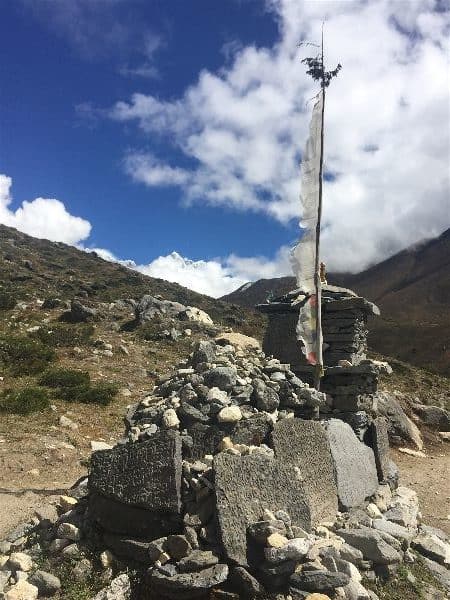
A makeshift religious site, with tablets inscribed with scriptures and covered with tattered and worn prayer flags
The mountains laid even more naked to see without the trees blocking them. The harshness of the landscape could be felt. The first thing I thought of as I felt the cold, crudeness of the landscape was that a long time ago Sir Edmund Hillary’s expedition walked this route. No teahouses. All of the gear necessary was on their person. And they were heading up Everest, not just to it. The idea alone of that is impressive.
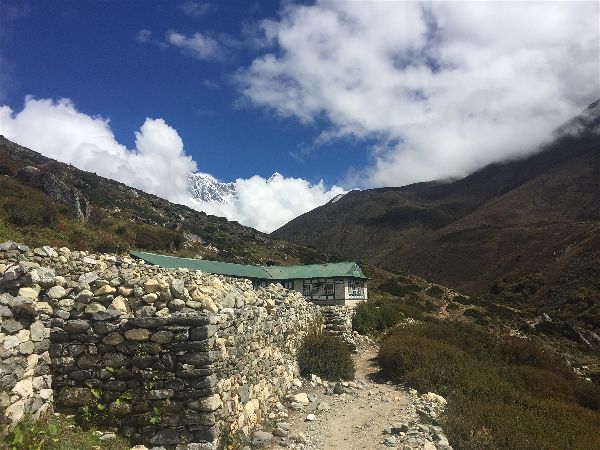
A house on the road to Pheriche. Stone takes the place of wood in construction as elevations get higher and vegetation becomes more sparse
Pheriche: A taste of the barren
As the trail descended from the mountain into the valley and forked left, away from Dingboche, to cross a rushing stream, there wasn’t a single tree in sight. Just rocks. And buildings made of rocks.
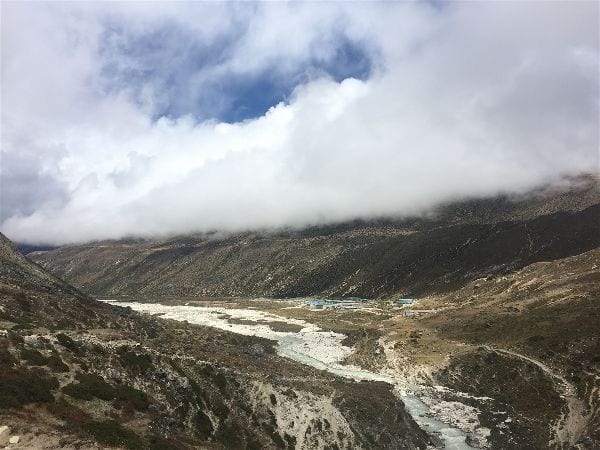
As I walked into the tiny hamlet of Pheriche and took in the sights I realized, there wasn’t a single wooden structure in sight. A packed, dirt path made up the tiny, main street with buildings of stone on lining each side. Patties of Yak dung lined the tops of the stone walls, drying to be used as fuel for fires in the dark hours. Stone buildings lined the main street, sitting just behind the waist high rock wall. Satellite dish shaped solar heating devices sat in the yards of each shop and teahouse…but not a single plank of wood in sight. That absence was a testament to the harshness of this climate and how the locals adapted their lives. Impressive.
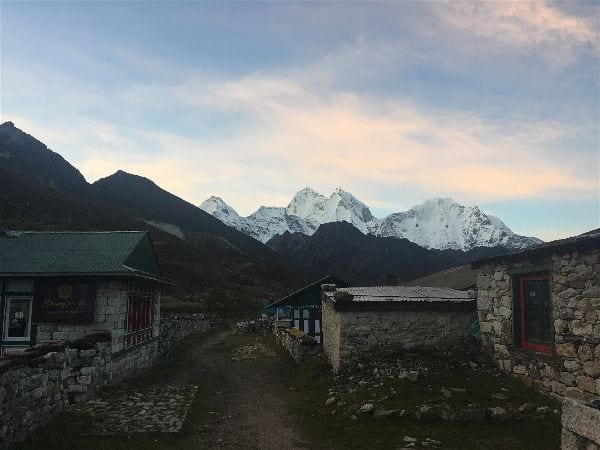
Pheriche – a tiny town made of stone between Tengboche and Gorak Shep
But building the structures of an entire village with no wood did not extend to the interiors. I picked the first teahouse I saw. I lucked out, because it was brand spanking new. Inside the building was lined with dark woods, comfy chairs, and cushy pillows. Funny enough, it only cost 200 Rupees to stay the night at this establishment. The same price I paid to stay at the last establishment with the Chinese Delegation and their screamer, except the walls there weren’t thin, and the welcome party at this teahouse was quite entertaining.
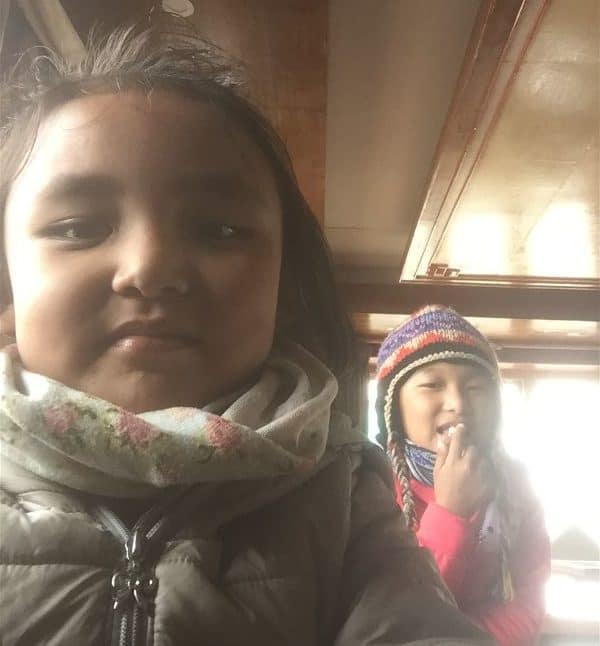
Pheriches Edelweiss welcome staff teaching me how to properly take a selfie – they demanded help with their English homework as payment
The moral of the story: On the Everest Base Camp Trek, just go as comfy as possible. If you’re fond of solitude, go for Pheriche. As nice as this teahouse was, I only had to share it with two other visitors.
The Plan for Tomorrow – Rest in Pheriche and enjoy the view
My trek was shaping up nicely. No more symptoms of altitude sickness (or stupidity) and I was feeling exceptionally strong by the time I laid my head down for the night. With a rest day planned for tomorrow in Pheriche, to acclimatize, I would be ready to sprint up to Gorak Shep in two days. Or so I thought.
PART 6: “The final stretch to Gorak Shep” Coming Soon…
RETURN TO PART 4 “A day of rest and a view of Everest”


ABOUT THE AUTHOR
Carlos is a nomad, slow traveler, and writer dedicated to helping others live abroad and travel better by using his 7+ years of experience living abroad and background as a management consultant and financial advisor to help other nomad and expats plot better paths for an international lifestyle. Click here to learn more about Carlos's story.

Malcolm Klein
Saturday 3rd of August 2019
I am planning a trip to EBC and this is a great overview of what lies ahead. Thanks for a wonderful narrative.